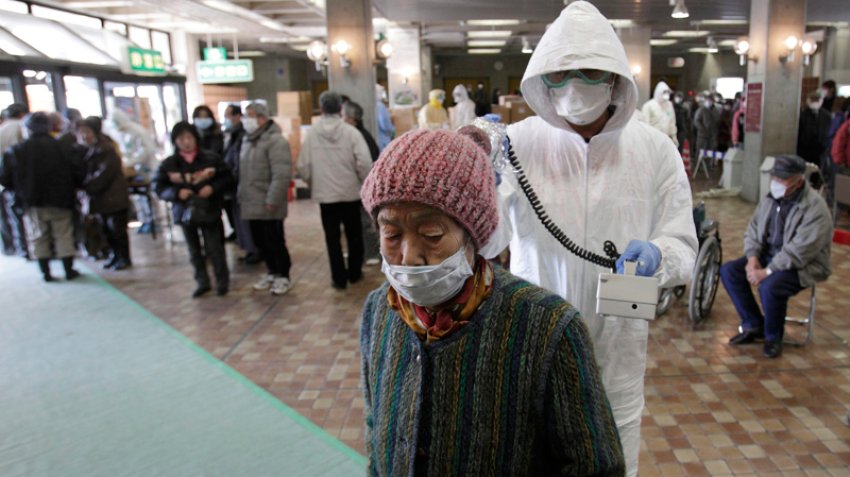
There's every likelihood that radioactive by-products of Australian uranium have spewed into the atmosphere from the nuclear reactor plant at Fukushima in Japan.
BHP Billiton and Rio Tinto export uranium from Australia to Japanese nuclear company TEPCO from the Olympic Dam and Ranger mines.
Despite being a major uranium supplier to Japan, Australia has turned a blind eye to serious, protracted problems with Japan's nuclear industry. It is time for a more responsible approach.
The earthquake on March 11 led to the automatic shutdown of the operating nuclear reactors at Fukushima.
However, TEPCO failed in its duty to maintain back-up electricity supply to run pumps to cool the intensely hot and radioactive nuclear cores. That, in turn, led to multiple fires, explosions and radiation releases.
Earthquakes have affected several nuclear plants in Japan. The most serious was the major 2007 earthquake that led to the shutdown of all of TEPCO's reactors at the Kashiwazaki-Kariwa plant in Niigata — not far from Fukushima, but on the west coast.
Radiation was released from two reactor buildings, from a pool containing spent nuclear fuel rods, and from 40 drums of nuclear waste that fell over and lost their lids.
There is a history of distrust surrounding TEPCO.
All of TEPCO's reactors were involved in a 2002 safety data falsification scandal, which led to protracted reactor shutdowns for inspections and repairs.
The “malpractices” were revealed to have been many and varied — and to have been ongoing for up to 25 years.
There have been many other incidents of data falsification involving reactors in Japan since the 2002 scandal. There have been further revelations about past incidents such as TEPCO's concealment of an emergency shutdown of one of the reactors at Fukushima in 1984.
Distrust of TEPCO grew as a result of the 2007 earthquake in Niigata. The company provided conflicting information over a period of several days,. It later acknowledged that the radiation releases would have been reduced if procedures were correctly followed.
Nuclear Engineering International reported: “Japan's nuclear industry has been suffering in the glare of negative publicity brought about by revelations that operators had covered up accidents and problems for decades.
“When it became public knowledge, it was hoped that the public relations disaster that companies were engineering for themselves might lead the wider industry to realise the potential benefits of being more open and honest when problems do crop up. That hope seems to have withered again in Niigata.”
A growing list of accidents are testament to the mismanagement of nuclear power in Japan. Some of the more serious accidents include:
- A sodium leak and fire at the Monju fast breeder plant in 1995.
- A reprocessing waste explosion at Tokai in 1997.
- Fifty tonnes of primary coolant leaked from a reactor at Tsuruga in 1999, leading to a sharp increase of radiation levels inside the reactor building.
- Following a criticality accident at a uranium conversion plant at Tokaimura in 1999, two people died and hundreds were irradiated.
- In 2001, a water pipe at Hamaoka-1 exploded, releasing radioactive steam into the containment building.
- In 2002, 16 workers were irradiated after a water pipe leak at Hamaoka-2.
- At the Mihama nuclear power plant in 2005, a pipe failed due to corrosion, resulting in the deaths of five workers and injuries to six others. The thickness of the failed pipe had not been checked since the plant went into operation in 1976.
A vicious cycle is evident. Mismanagement and slack regulation beget accidents and scandals. The authorities respond with denial and deceit, which later gives way to profuse apologies, resignation and solemn promises of improved performance in future.
Then it's business as usual — mismanagement and slack regulation beget the next accident or scandal. And the cycle repeats.
The pattern of mismanagement, accidents and scandals is reflected in public opinion. A 2005 survey by the International Atomic Energy Agency found that just 21% of Japanese citizens support the construction of new reactors; 76% are opposed.
Of the 18 countries surveyed, only four were more strongly opposed to the construction of new nuclear reactors.
As a major uranium supplier, Australia could play a role in breaking this vicious cycle by making uranium exports conditional on improved management of nuclear plants and tighter regulation.
Indeed, Australia has a responsibility to either insist on better performance or to cease uranium exports to Japan. The business-as-usual option makes us complicit in the ongoing fiasco of Japan's nuclear industry.
Australia is also complicit in fanning regional proliferation tensions by providing Japan with open-ended permission to separate and stockpile weapons-useable plutonium produced in power reactors from Australian uranium.
A 1993 US diplomatic cable posed these questions: “Can Japan expect that if it embarks on a massive plutonium recycling program that Korea and other nations would not press ahead with reprocessing programs?
“Would not the perception of Japan's being awash in plutonium and possessing leading edge rocket technology create anxiety in the region?”
Since 1993, Japan's plutonium stockpile has grown enormously and regional tensions are sharper than ever. Yet Australia continues to provide open-ended approval for Japan to stockpile plutonium.
It also continues to turn a blind eye to the pattern of accidents, scandals and cover-ups.
[Jim Green is the national anti-nuclear campaigner with Friends of the Earth, Australia.]
Comments
Anonymous replied on Permalink
David replied on Permalink
steff_01 replied on Permalink